Age Fifteen: Chairgirl
203. Chairman of the Communist Party of China
When the Communist Party of China (CPC) was established in 1921, its founders selected the Marxist activist and theorist Chen Duxiu (1879–1942) to be its first official leader. Initially serving under the title Secretary of the Central Bureau, then as Chairman of the Central Executive Committee, and finally as General Secretary of the Central Committee, Chen advocated a revolutionary movement with broad support from the middle classes and close ties to communist groups abroad. His rival Mao Tse-tung (1893–1976) advocated a more distinctively Chinese version of communism, with mass mobilization of the peasants and rural laborers. As Mao became more powerful, he and his allies managed to undermine support for Chen, who resigned under pressure in 1927.
Chen was succeeded by Xiang Zhongfa, who was followed by Bo Gu. Neither were very powerful or charismatic, and the CPC suffered a series of serious defeats during their time in office. By 1934, Chiang Kai-shek’s nationalist army had surrounded the communist forces and was preparing to annihilate them. Mao led the communists in a daring breakout from the encirclement, and then on an epic 5,600-mile retreat to escape pursuing nationalist forces. This event, known as the Long March, cemented Mao’s reputation, and from 1935 onward, he was clearly the most powerful person in the CPC. Mao had his supporter Zhang Wentian elected General Secretary, and focused his own efforts on leading communist forces during their 1937–1943 campaign to repel the Japanese invasion of China.
In 1943, Mao abolished the General Secretary title and personally assumed office as Chairman of the Politburo. Two years later, he also took the title Chairman of the Central Committee. Unlike his predecessors, Mao had enormous personal power and wide support from the common people. This allowed him to control the CPC with little interference from other factions. When the communists won the Chinese Civil War and drove the nationalists into exile in Taiwan, Mao became the unchallenged leader of mainland China. On October 1, 1949, Mao founded the People’s Republic of China. The CPC transitioned from being a revolutionary party and a military insurgency into the ruling party of a sovereign nation. Mao had almost total power, and ruled as a dictator until his death in 1976.
During his time as leader of China, Mao had a variety of titles. At first, he was the legal head of state as State Chairman. He then made Liu Shaoqi the head of state from 1959 to 1968, before abolishing that position. Mao was never Premier, which is the legal head of government, instead his deputy Zhou Enlai served in that role. But regardless of which titles Mao held at any one time, he was universally acknowledged as the Paramount Leader of the People’s Republic of China.
After Mao’s death, he was succeeded as Chairman of the CPC and Paramount Leader by Hua Guofeng, who was also the legal head of government as Premier and chairman of the powerful Central Military Commission. Hua ruled for two years, before he was outmaneuvered by Deng Xiaoping (1904–1997), who held power as Paramount Leader from 1978 to 1989 without holding any of the highest formal offices in the country. The Party Chairmen who served under Deng were not very powerful, and mostly acted as loyal subordinates of Deng. In 1982, the office of Chairman of the Communist Party was abolished, with the party leader retitled General Secretary of the Communist Party. Yet because leading the CPC is so strongly associated with Chairman Mao, the General Secretary is still sometimes referred to in the West as the Chairman.
![]()
In the alternative reality of Danielle: Chronicles of a Superheroine, when fifteen-year-old Danielle goes to China, President Hu serves as head of state, while Chairman Zhao serves as General Secretary of the Party. Zhao becomes a supporter of Danielle, and is arrested for helping her. After talking with Dad, Danielle realizes that she has to find a way to become leader of the CPC in order to protect Liu and safeguard her political efforts for reform in China and Tibet. After outmaneuvering Premier Zhongfa, who opposes her, Danielle manages to gain sufficient support on the Central Committee. Following a tradition of voting overwhelmingly for a consensus candidate, the Central Committee members elect Danielle Chairman of the Communist Party of China. She suggests that “Chairgirl” is more fitting, given that she is fifteen years old.
See entries for Mao Tse-tung, Chiang Kai-shek, Kuomintang, Chinese Communist Party, Mao’s Long March, President Hu, the Tibet Question, People’s Liberation Army, Tibetan Buddhism, Deng Xiaoping, Authoritarian, and the Central Committee of the Chinese Communist Party.
How You Can Be a Danielle and promote democracy in China.
204. Mandarin
Mandarin is the dialect that forms the basis for the Standard Chinese language. It originated in northern China in the areas around Beijing, and was named after the mandarins, a term for government bureaucrats during the Ming Dynasty (1368–1644). In China, it is commonly called Putonghua, which means “common speech.” Mandarin is the largest of the seven main groups of Chinese dialects, and is the official language of China and Taiwan. More people speak Mandarin as their first language than any other, and including those who learn it as a second language, there are more than one billion Mandarin speakers in the world. Unless there is another dialect specified, Mandarin and Chinese are synonymous.
Linguists classify Mandarin as being in the Sino-Tibetan family of languages. It is a tonal language, which means that changes in vocal pitch can change the meaning of a word, even if the rest of the pronunciation stays the same. For example, the word “ma” spoken with a high, steady tone means “mother.” But if spoken with a pitch that briefly goes downward and then rises, it means “horse.” Mandarin has four different tones: high and level, rising, falling then rising, and falling.
Written Mandarin is a logographic language. Unlike English, where each character in the alphabet represents a sound with no meaning of its own, Chinese characters represent whole words and ideas. While English uses the four letters T-R-E-E to represent a tree, Chinese uses one character that vaguely resembles an actual tree: 木. Some Chinese characters have to be memorized as a whole, with none of their parts contributing meaning. But most characters contain elements called radicals, which represent some part of the meaning. Originally, Chinese characters were typically written with an ink brush, so consist of a series of discrete “strokes” of the brush. A radical is usually just a few strokes, but the whole character may have a dozen strokes or more. The most complex character in common use uses 36 strokes to mean “verbose.” In total, linguists estimate that there are more than 50,000 Chinese characters, but most of those are hardly ever used. About 3,000 characters are in relatively frequent use, and an educated person might recognize about 8,000.
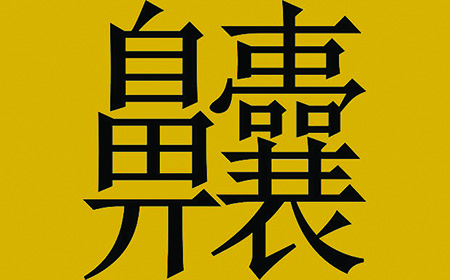
The Chinese word “nang,” which consists of 36 strokes, and means “verbose”
Up until the Xinhai revolution of 1911, most formal writing in China used versions of Classical Chinese, which is very different from spoken Mandarin. But both the republican nationalists and the communists encouraged use of Mandarin as a way of unifying the nation and making it easier for the common people to learn how to read.
The Japanese written language (Kanji) borrows heavily from the written Chinese (hànzi) characters but the same written character in Japanese generally has a different meaning than the same one in Chinese.
![]()
In the alternative reality of Danielle: Chronicles of a Superheroine, Danielle learns to speak Mandarin, but has some struggles. During a debate against Pinyin Shaoqi for president of China, fifteen-year-old Danielle inadvertently says that “Chinese history is decidedly tedious.” She had intended to say that China has a very long history. This is very embarrassing for her and hurts her campaign. She acknowledges that she is not an expert on the Chinese language, but argues that “Shaoqi is not an expert on democracy.” She makes an ad campaign to send this message, which includes her speaking a perfectly pronounced message in Mandarin. She succeeds, and becomes China’s first democratically elected president at age fifteen.
See entries for Han Chinese, Kuomintang, and Chinese Communist Party.
How You Can Be a Danielle and promote democracy in China.
205. Nano-based solar energy production
Several groups of technologies allow conversion of solar energy into electricity. At first, the most common means of generating solar electricity involved using large mirrors to concentrate sunlight in a small area. This causes intense heat at the point of focus, which can be used to boil water, creating steam that drives a turbine, which spins a magnetic dynamo and creates electric current.
![]()
Price history of silicon PV cells in US$ per watt
An alternate approach involves a phenomenon called the photovoltaic effect. When certain materials absorb sunlight, the photons in the light excite electrons in the material and create an electric current directly. Thus, photovoltaic technology simplifies solar power by directly converting light into electricity, without the need for mirrors, heat, steam, or moving parts.
The problem is that when photovoltaic technology was first developed, it was very inefficient. In 1954, Bell Labs announced a solar cell that converted about 6 percent of the energy in sunlight into usable electricity. Innovations improved the efficiency of subsequent versions, but they remained so inefficient that they were mainly only used where other power sources were not available. For example, during the 1950s and 1960s, photovoltaic cells were used to power many systems aboard satellites and other spacecraft. But this was very expensive, and yielded so little electricity that the spacecraft had to be specially designed to accommodate this limitation. Solar power was still too weak and expensive to compete with fossil fuels for generating most of the electricity used by homes and businesses.
Making solar commercially viable required the convergence of two trends: increasing cell efficiency and decreasing cell price. These factors combined to increase solar’s cost-effectiveness, which has allowed it to gradually replace more and more fossil fuel power.
By 1960, photovoltaic cells had reached 14 percent efficiency in laboratory settings, and by 1985, this had increased to 20 percent. By 2015, experimental solar cells had achieved up to 44 percent efficiency, with 15 percent common in practical usage. Meanwhile, prices have been consistently falling. These trends combined to drastically improve price-efficiency over the last four decades.
Photovoltaic cells have become much less expensive in recent decades, which is allowing solar to become more competitive with fossil fuels as a source of commercial electricity.
In 1977, it cost about $76 for a photovoltaic cell capable of generating one watt of solar electricity. By 1987, an equivalent cell cost of less than $10 dollars. In 2015, a one-watt cell was only $0.30, plus about another $3 for installation costs. This follows a trend implied by my Law of Accelerating Returns, which observes that the price of photovoltaic modules drops by 20 percent every time total worldwide installed photovoltaic capacity doubles.
As the price-efficiency of solar electricity has improved, it has steadily become a larger share of global energy. Over the last quarter of a century, the fraction of the world’s electricity capacity generated from solar power has doubled on average about every two years. For example, in 2012, roughly half a percent of the world’s electricity came from solar, which doubled to 1 percent by 2014, and has doubled again by 2016.
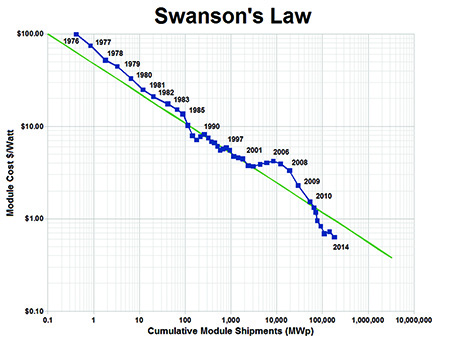
The exponential decline in the cost per watt of solar energy
As photovoltaics become cheaper and more efficient, this trend is likely to continue until solar becomes the dominant energy source on earth in the next two decades. Unlike fossil fuels, which are nonrenewable and have already been exhausted in some areas, solar energy is vastly more abundant than we need. Even if 100 percent of the world’s total energy use came from solar, it would only require 1/10,000th of the available sunlight on the planet.
![]()
Close-up of the surface of black silicon, covered with tiny needles that trap light and increase photon absorption
For solar to continue expanding, advances in materials science will be necessary to enable further improvements in cost-efficiency. Breakthroughs in nanotechnology will increase cell efficiency by allowing photovoltaic cells to capture energy from more of the electromagnetic spectrum. Putting tiny structures called nanotubes and nanowires inside cells can steadily improve their ability to absorb photons, transport electrons, and generate electric current. Scientists have shown that putting nanocrystals (sometimes termed quantum dots) inside cells can increase the amount of electricity generated per photon of sunlight absorbed.
Another nanomaterial called black silicon has a surface composed of a vast number of atom-scale needles smaller than the wavelength of light. This nearly eliminates reflections from a cell, ensuring that more photons create electricity. At Princeton, researchers are working on an alternate method of accomplishing this, using a nanoscale mesh of gold atoms just 30 billionths of a meter thick to trap photons and increase efficiency. Meanwhile, a project at MIT has created photovoltaic cells from sheets of graphene, a special form of carbon that is only one atom thick (less than a nanometer). These technologies will allow photovoltaics of the future to be thinner and lighter, and able to be installed on more surfaces. For example, a Norwegian company called EnSol AS is developing a thin photovoltaic film that can coat windows, producing useful electricity without blocking the view.
In the years ahead, nanotechnology will reduce manufacturing costs by facilitating 3D printing of solar cells. This will also make decentralized production possible, so photovoltaics can be created when and where they are needed. And unlike the big, clumsy, rigid panels used today, cells built with nanotech can take many convenient forms: rolls, films, coatings, and more. This will reduce installation costs and give more communities around the world access to solar power.
![]()
In the alternative reality of Danielle: Chronicles of a Superheroine, when Danielle is elected president of China at age fifteen, she encourages adoption of new technologies to improve quality of life for the people. She opposes the Chinese One Child Policy in her first presidential address, noting that China’s population problem is a myth. She says that due to new technologies like nano-based solar energy production, decentralized water purification cells, vertical agriculture, and 3D-printed building modules, there will be plenty of resources to accommodate an expanded population.
See entries for Nanotechnology, Three-dimensional printing, Vertical agriculture, Decentralized water purification cells, Three-dimensional printing of building modules, and China’s One Child Policy.
206. Decentralized water purification cells
One of the key challenges of the twenty-first century will be making sure that earth’s growing population has a reliable supply of clean fresh water. In 1990, about 24 percent of the world’s people did not have regular access to safe drinking water. Thanks to development efforts and improving technology, that fraction is now down to about 9 percent. Still, this amounts to over 660 million people and causes immense human suffering. According to the World Health Organization’s last estimate, about 1.9 million people around the world die each year from diseases that spread through water—mostly via drinking water that gets contaminated by the bacteria in feces. These diseases include cholera, dysentery, and typhoid fever and are particularly deadly to children.
Ensuring that this last 9 percent gets clean water will be challenging. Much of the globe still lacks the infrastructure to collect fresh water, keep it clean, and deliver it to homes for people to use for drinking, cooking, washing, and bathing. Constructing huge networks of wells, pumps, aqueducts, and pipes is extremely expensive, and many developing countries cannot afford to do so. In other cases, civil wars and other political problems make large infrastructure projects impossible. As a result, centralized water purification and distribution systems like those in developed countries are not a viable solution for that last 9 percent. The alternative is technologies that allow people to purify water in their local neighborhoods.
In general, decentralized technologies will dominate the early twenty-first century in many areas, including energy production (solar cells), food production (vertical agriculture), and production of everyday objects (three-dimensional printing).
This decentralized approach can take several forms, ranging from large machines that purify water for a whole village down to portable cells that individual people can use.
Some purification cells use heat—from solar energy, or burning fuels—to boil water before use. Boiling kills disease-causing bacteria, but does not remove other toxic pollutants, and it is easy for the water to become recontaminated if it is not consumed immediately after boiling. Adding antibacterial chemicals to the water can prevent recontamination, but still does not remove other toxins.
In recent years, some portable water purification cells have used electricity to turn oxygen in the air into ozone, a gas that can be passed through water to kill pathogens very efficiently. Others kill bacteria and viruses by shining strong ultraviolet through the water.

An individual-sized purifier that uses ultraviolet light to make water safe to drink
An alternate method is filtration. For many years, filtration technology was able to get most organisms and toxins out of water, but not all of them. Many of the deadliest viruses are so small that they pass through the holes in ordinary filters. Similarly, the molecules of some pollutant chemicals cannot be blocked by normal filtration. Yet recent innovations in materials science are creating filters that keep out smaller and smaller toxins. In the coming years, nanotechnology will enable filters to work faster and be very inexpensive.
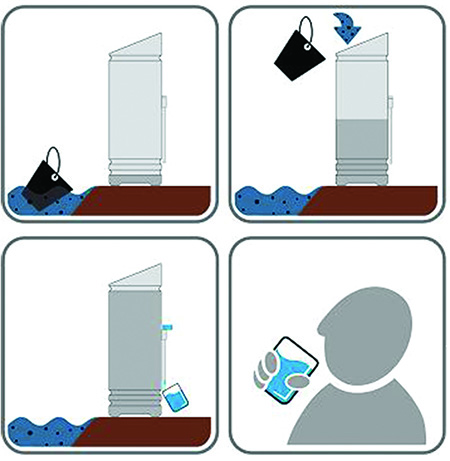
The Portable Aqua Unit for Lifesaving (PAUL) filtration system uses simple directions like these to show how easily someone without any training can use it to create safe drinking water
An especially promising emerging technology is the Slingshot water machine invented by Dean Kamen (born in 1951). It is a relatively small machine (about the size of a small refrigerator) that can produce totally pure water (that actually meets the standards for an injectable liquid) from any source including sewer water and contaminated swamp water. The Slingshot requires less than one kilowatt of electricity to operate. It uses vapor compression (turning the input water into steam leaving contaminants behind) and requires no filters.
The Slingshot is intended to be powered by another Kamen invention, a Stirling engine, that can produce electricity from any fuel including cow dung.
![]()
In the alternative reality of Danielle: Chronicles of a Superheroine, at the age of six, Danielle goes to Zambia with her sister Claire and her dad to help solve a drought by installing Kamen Slingshot water machines. She succeeds in solving one third of one percent of the water problem there, but her friend Amu, a native Zambian girl, goes on to make further progress. As president of China at age fifteen, Danielle encourages decentralized water purification technologies as a way of meeting the growing water needs of China’s expanding population.
See entries for World Health Organization, Zambia, Zambian drought, Slingshot water machine, Nano-based solar energy production, Three-dimensional printing, Vertical agriculture, and Three-dimensional printing of building modules.
How You Can Be a Danielle and combat drought and polluted water in poor nations.
207. Vertical agriculture
When humans first began cultivating crops about eleven thousand years ago, the amount of food that could be grown from a given area of land was quite low. The first farmers sprinkled seeds into the natural soil and let the rain water them. The result was that the vast majority of the population needed to work in agriculture just to survive.
As technology developed, higher density of crops became possible. Irrigation allowed crops to receive more water than they could get from rain alone. Plant breeding enlarged the edible parts of plants and made them more nutritious. Fertilizers supercharged the soil with substances that promote growth. Better agricultural methods allowed farmers to plant crops in the most efficient arrangements possible. The result was that more food was available, so over the centuries, more and more people could spend their time on things like trade, science, and philosophy. Improvements in agricultural efficiency made modern civilization possible.
Even in the last century, agricultural technology has made great advances. In 1900, 38 percent of Americans worked on farms. Now, it is about 2 percent. The reason is that crops are grown at extremely high density and machines do a lot of the work that used to be done by hand. Thus, one farm worker can grow enough food to feed about fifty people. Yet crop densities are now so high that they are approaching the theoretical limit of how much food can be grown in a given area. One emerging solution is to grow several stacked layers of crops: vertical agriculture.

Lettuce growing in stacked layers on a vertical farm
Vertical farms take advantage of several technologies to make this possible. Typically, they grow crops hydroponically, meaning that instead of soil, the plants sit indoors in trays of nutrient-rich water. These trays are loaded into frames and stacked many stories high, which means that excess water from one level can trickle down to the next instead of being lost as runoff. Instead of sunlight, special LEDs are installed to ensure that each plant gets the perfect amount of light. Some vertical farms now use a new approach called aeroponics, where the water is replaced with a fine mist. The result is that crops can be grown using about 95 percent less water than on a normal farm.
Vertical farming has other key advantages. It prevents agricultural runoff, which is one of the main causes of pollution in waterways. It avoids the need for farming loose soil, which gets blown into the air and reduces air quality. It makes toxic pesticides unnecessary. It allows for cultivation of crops year-round, including species that could not grow in the local outdoor climate. It prevents crop losses due to frosts and bad weather. It will substantially reduce the need to use valuable land for agriculture, which is now estimated at 36 percent of usable land. Perhaps most importantly, it means that cities can grow their own food instead of bringing it in by trains and trucks from hundreds or even thousands of miles away. As vertical agriculture becomes less expensive and more widespread, this will allow great reductions in pollution and emissions.
In the coming years, converging innovations in photovoltaic electricity, materials science, robotics, and artificial intelligence will make vertical farming much less expensive than current agriculture. Many facilities will be powered by efficient solar cells, produce new fertilizers onsite, collect their water from the air, and harvest the crops with automated machines. With very few workers required and a small land footprint, future vertical farms will be able to produce crops so cheaply that consumers may be able to get food products almost for free.
This mirrors what has happened in information technology due to the Law of Accelerating Returns. As computing power has gotten exponentially cheaper, companies like Google and Facebook have been able to provide their services for free to users, while paying for their own costs by selling ads.
In the alternative reality of Danielle: Chronicles of a Superheroine, after her election as president of China at age fifteen, Danielle supports vertical agriculture technology as a way of efficiently producing the food needed to sustain China’s growing population.
See entries for Artificial Intelligence and Nano-based solar energy production.
How You Can Be a Danielle and help the people in developing nations.
208. Three-dimensional printing
For most of the twentieth century, manufacturing three-dimensional parts usually took two forms. Some processes involved shaping material inside a mold, such as injecting molten plastic into a tooling, or shaping heated metal in a press. Other processes involved selectively removing material from a block or sheet, much like a sculptor chipping away at a marble block to carve a statue. Both of these methods have major disadvantages. Creating molds is very expensive, and the molds are quite hard to modify once completed. Meanwhile, so-called subtractive manufacturing wastes a lot of material, and is unable to produce some kinds of shapes.
In the 1980s, though, a new family of technologies began to emerge. Unlike previous methods, they created parts by stacking or depositing layers of relatively flat shapes, building them up into a three-dimensional shape. These techniques have come to be known as additive manufacturing, three-dimensional printing, or 3D printing.
The most common types of 3D printers work somewhat like an inkjet printer. A typical inkjet has a cartridge of ink and passes back and forth over a piece of paper, squirting ink out of a nozzle in the places software directs it to. Instead of ink, 3D printers heat a material like plastic until it is soft. The nozzles deposit the material following a software-run pattern for each layer, repeating the process many times as the object gradually becomes more three-dimensional. The layers fuse together as they harden, and the finished object is ready to use.
Over the last two decades, 3D printing has become much more advanced and is on the verge of major new breakthroughs. 3D printing systems can now create objects out of a wide variety of materials including paper, plastic, ceramic, and metal. They are rapidly getting faster and less expensive. New, intuitive software is making it easier for people to create 3D-printed parts without advanced training.

A 3D printer constructing two small models of buildings
As three-dimensional printing becomes more widespread, it is starting to revolutionize the manufacturing industry. One major advantage is that it allows cheap and fast prototyping. Engineers can design a new part on their computers and hold a 3D-printed model in their hands within minutes or hours—a process that might have taken weeks with previous technology. This allows rapid cycles of testing and modification, for a fraction of the cost of old methods. As a result, people with good ideas but relatively little money can bring their innovations to the marketplace.
Another key advantage of 3D printing is that it allows levels of customization that are not practical with mold-based manufacturing. Even a slight modification usually requires a whole new mold, which can cost tens of thousands of dollars or more! By contrast, even major changes to a 3D-printing design don’t carry any additional cost. As a result, inventors can have exactly the right parts they need to innovate, and consumers can affordably access products designed especially for them. One example among many is producing shoes made to the exact measurements of a customer’s feet, for greatly enhanced fit and comfort. Similarly, furniture can be molded to fit every body type and tools molded to fit your own hand. Of even greater importance, vital medical implants will be cheaper and more effective.
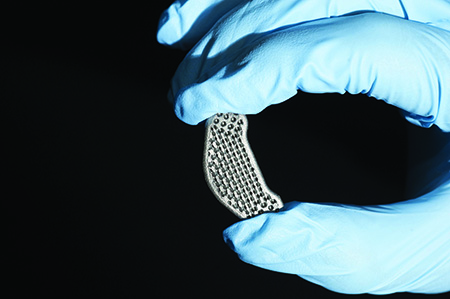
A 3D-printed titanium spinal disk that can be implanted in patients with spinal damage or disease
In addition, 3D printing allows manufacturing to be decentralized, empowering consumers and local communities. During the twentieth century, manufacturing was concentrated in giant corporate factories in major cities. Small towns and developing countries had to buy their products from far away, and had little control over how they would be customized. As 3D printing technology becomes less expensive and more advanced, people will be able to create a vast array of objects for themselves, to whatever specifications they prefer. Decentralized manufacturing will also have significant environmental benefits. Shipping products from factories to consumers hundreds or thousands of miles away generates heavy emissions of pollution.
The fine resolution of key features is exponentially declining. Once it is below a micron (a millionth of a meter), expected around 2020, it will be feasible to print out clothing.
In addition to manufacturing of everyday goods like shoes or tools, new research is applying 3D printing to biology. Scientists are currently testing tools that will allow the printing of human body tissues or, ultimately, even whole organs. The general principle is that a biologically inactive material, such as ceramic, is printed into a three-dimensional “scaffold” in the shape of the desired body structure. Fluid rich with reprogrammed stem cells is then deposited over the scaffold, where the cells multiply and fill in the appropriate shape thereby creating a replacement organ with the patient’s DNA. United Therapeutics (a company that I am on the board of) is applying this approach to grow lungs, kidneys, and hearts. This approach is vastly superior to transplanting organs from one person to another, which has profound limitations in terms of availability and incompatibility with a patient’s immune system.
One potential drawback of 3D printing is that it could be used to manufacture “pirated” designs. Why pay $200 for a pair of designer shoes if you can download the file and print them for yourself at a fraction of the cost? This will require new approaches to protect intellectual property.
A more troubling implication is that decentralized manufacturing will allow civilians to create weapons that they otherwise couldn’t easily access. Already, files are circulating on the Internet that let people print the parts to assemble their own guns. This will make gun control more difficult, and could allow people to create firearms with no serial numbers, making it harder for law enforcement to trace crimes. 3D-printed guns made from advanced plastics could even be used to smuggle weapons through metal detectors. This will require a thoughtful rethinking of current regulations and policies.
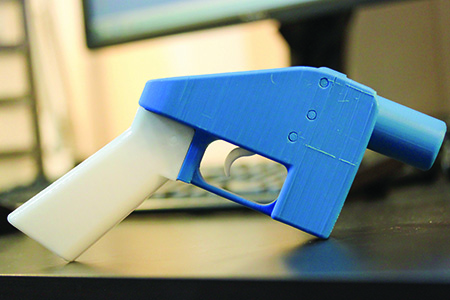
A 3D-printed gun, designed by the company Defense Distributed
As three-dimensional printing technology advances, it will be able to handle more exotic materials. For example, medical implants may be created with drug molecules built in, to be gradually released into the body. Nanomaterials like graphene could be used to create lightweight bulletproof clothing and superfast electronics. 3D printing can also benefit from advances in artificial intelligence, such as software that can optimize an object’s properties like strength or aerodynamic shape, even if those designs require shapes that would be impossible to manufacture with contemporary methods.
![]()
In the alternative reality of Danielle: Chronicles of a Superheroine, after her election as president of China at age fifteen, Danielle promotes new technologies to improve living conditions for the country’s large population. Thanks to emerging fields like nano-based solar energy production, decentralized water purification cells, vertical agriculture, three-dimensional printing, and 3D-printed building modules, the necessities of life can be produced even with an expanded biological population.
See entries for Nanotechnology, Nano-based solar energy production, Vertical agriculture, Decentralized water purification cells, and Three-dimensional printing of building modules.
209. Three-dimensional printing of building modules
Three-dimensional printing is usually associated with manufacturing small objects such as tools or medical implants, but it can also be used to create larger structures. This technology is rapidly advancing through prototype stages, and as 3D-printed buildings become less expensive to produce, they will become a commercially viable alternative to current construction methods.
There are two main approaches to 3D printing a building. The first is to create parts or modules that are subsequently put together—much like people buying furniture parts from IKEA and assembling them on their own. In some cases, this means printing parts like wall sections and roof segments, and then connecting them at the construction site, much like snapping together Lego parts.
Another approach is printing the structures of whole rooms at once. These modules usually have square or rectangular footprints and can fit together in many different configurations. At the construction site, they can be lifted into position by cranes and assembled quickly. This minimizes the disruption and nuisance that construction normally causes to the surrounding area. China is already a hub of 3D-printed building, and in 2014, Chinese firm WinSun demonstrated building 10 simple modular houses in 24 hours, at a cost of less than $5,000 each.
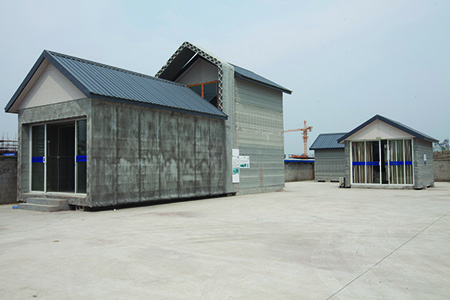
The basic construction of a modular home 3D-printed by WinSun
Another method is to print the whole building as a single module. Engineers set up a large frame around the area where the building will be. The printing nozzle robotically moves around within that frame, depositing layers of material (for example, concrete) in the shape of the walls. Very little human labor is needed for the main structural construction, but after it is complete, workers can go in to finish the inside of the building and add additional elements such as windowpanes and roof tiles. For example, in 2016, the Huashang Tengda company announced completion of a two-story villa that had been printed in one piece in 45 days.
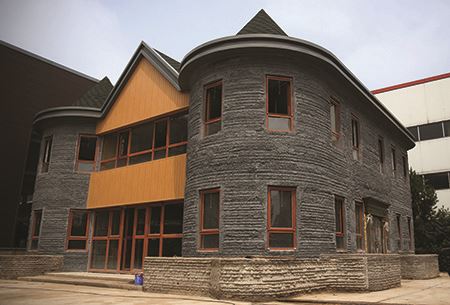
Huashang Tengda’s 3D-printed home in Beijing
3D printing of building modules has several key advantages, which will become even stronger as the technology develops. First, it cuts labor costs, which will allow basic housing to become more affordable. It also shortens construction times, which reduces the environmental impact that prolonged construction causes. This includes reducing factors such as the waste and garbage generated, light and noise pollution, toxic dust, traffic disruption, and hazards to workers. In addition, 3D printing makes it easier to construct buildings out of materials that are easily available, such as concrete, instead of using resources that might be hundreds of miles away, like timber and steel.
In the future, 3D printing may be used to make skyscrapers easier and cheaper to build. One of the main challenges of high-rise construction is getting people and building materials all the way to the upper floors. 3D printing machines that don’t require much human labor and can use building materials that are pumped up from the ground in liquid form will make this much easier.
![]()
In the alternative reality of Danielle: Chronicles of a Superheroine, as president of China, fifteen-year-old Danielle realizes that the country’s growing population will place strain on its natural resources. She solves this problem by supporting use of a group of technologies that make resource use more efficient, including nano-based solar energy production, decentralized water purification cells, vertical agriculture, three-dimensional printing, and 3D-printed building modules.
See entries for Nanotechnology, Nano-based solar energy production, Vertical agriculture, Decentralized water purification cells, and Three-dimensional printing.
How You Can Be a Danielle and help the people in developing nations.
